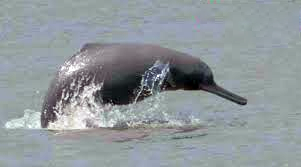Biodiversity & Environment
Gangetic River Dolphin
- 18 Feb 2021
- 5 min read
Why in News
Recently, a Gangetic Dolphin was beaten to death in Pratapgarh, Uttar Pradesh.
- Killing the Gangetic River Dolphin is a punishable offence under the Wildlife Protection Act, 1972.
Key Points
- About:

- Scientific Name: Platanista gangetica
- The Ganges River Dolphin was officially discovered in 1801.
- Ganges river dolphins live in the Ganges-Brahmaputra-Meghna and Karnaphuli-Sangu river systems of Nepal, India, and Bangladesh.
- The Ganges river dolphin can only live in freshwater and is essentially blind.
- They hunt by emitting ultrasonic sounds, which bounces off of fish and other prey, enabling them to “see” an image in their mind. They are also called ‘susu’.
- Population of Gangetic river Dolphin is 1200-1800.
- Significance:
- It is a reliable indicator of the health of the entire river ecosystem.
- It was recognised as the National Aquatic Animal in 2009, by the Government of India.
- Threats:
- Bycatch: These dolphins and people both favor areas of the river where fish are plentiful and the water current is slower. This has led to fewer fish for people and more dolphins dying as a result of accidentally being caught in fishing nets, also known as bycatch.
- Pollution: Industrial, agricultural, and human pollution is another serious cause of habitat degradation.
- Dams: Construction of dams and other irrigation-related projects make them susceptible to inbreeding and more vulnerable to other threats because they cannot move to new areas.
- Dolphins below a dam are threatened by heavy pollution, increased fishing activities and vessel traffic. They also have less food because dams disturb the migration, breeding cycles and habitat of fish and other prey.
- Conservation Status:
- Indian Wildlife (Protection), Act 1972: Schedule I.
- International Union for the Conservation of Nature (IUCN): Endangered.
- Convention on International Trade in Endangered Species (CITES): Appendix I (most endangered).
- Convention on Migratory Species (CMS): Appendix II (migratory species that need conservation and management or would significantly benefit from international co-operation).
- Steps Taken:
- Project Dolphin: The Prime Minister announced the government’s plan to launch a Project Dolphin in his Independence Day Speech 2020. It will be on the lines of Project Tiger, which has helped increase the tiger population.
- Dolphin Sanctuary: Vikramshila Ganges Dolphin Sanctuary has been established in Bihar.
- Conservation Plan: The Conservation Action Plan for the Ganges River Dolphin 2010-2020, which “identified threats to Gangetic Dolphins and impact of river traffic, irrigation canals and depletion of prey-base on Dolphins populations”.
- National Ganga River Dolphin Day: The National Mission for Clean Ganga celebrates 5th October as National Ganga River Dolphin Day.
Wildlife Protection Act, 1972
- This Act provides for the protection of the country’s wild animals, birds, and plant species, in order to ensure environmental and ecological security. Among other things, the Act lays down restrictions on hunting many animal species. The Act was last amended in the year 2006.
- The Act created six schedules which gave varying degrees of protection to classes of flora and fauna.
- Schedule I and Schedule II get absolute protection, and offences under these schedules attract the maximum penalties.
- Schedule 5 includes species that may be hunted.
Related Constitutional Provisions
- Article 48A:
- It directs the State to protect and improve the environment and safeguard wildlife and forests. This Article was added to the Constitution by the 42nd amendment in 1976.
- Article 51A:
- Article 51A imposes certain fundamental duties for the people of India. One of them is to protect and improve the natural environment including forests, lakes, rivers, and wildlife and to have compassion for living creatures.




